Unit 1 Art Using Language 1 Listening and Speaking(共17张PPT,内镶嵌音频)课件 2024-2025学年高二英语人教版(2019)选择性必修3
文档属性
| 名称 | Unit 1 Art Using Language 1 Listening and Speaking(共17张PPT,内镶嵌音频)课件 2024-2025学年高二英语人教版(2019)选择性必修3 | 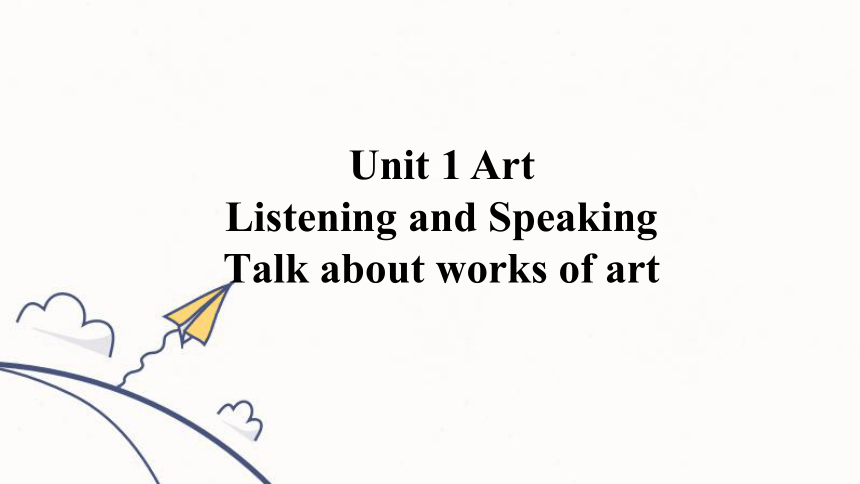 | |
| 格式 | pptx | ||
| 文件大小 | 44.2MB | ||
| 资源类型 | 教案 | ||
| 版本资源 | 人教版(2019) | ||
| 科目 | 英语 | ||
| 更新时间 | 2024-11-28 18:20:31 | ||
图片预览

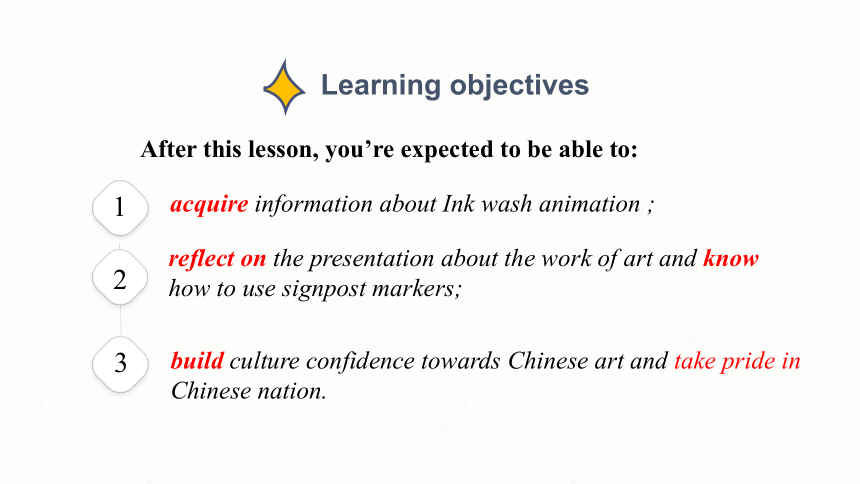
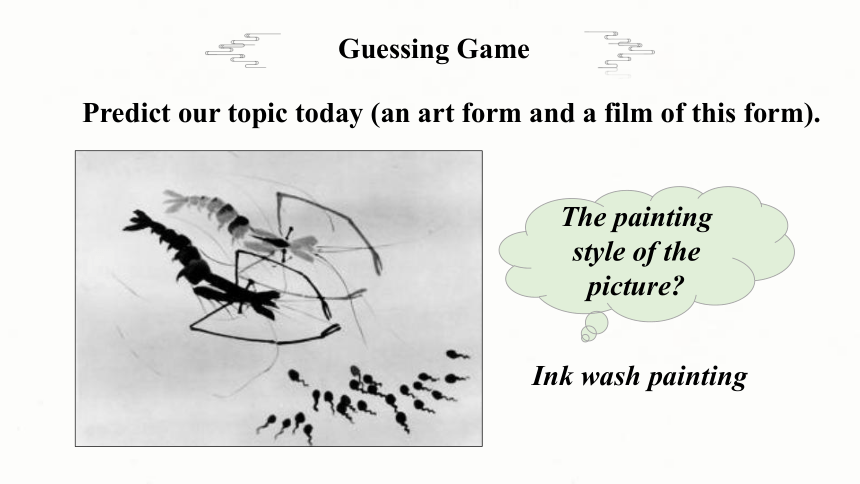

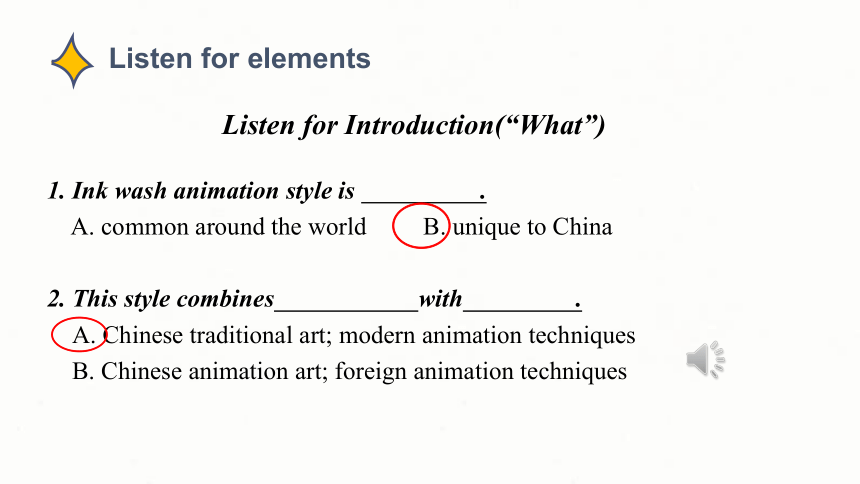

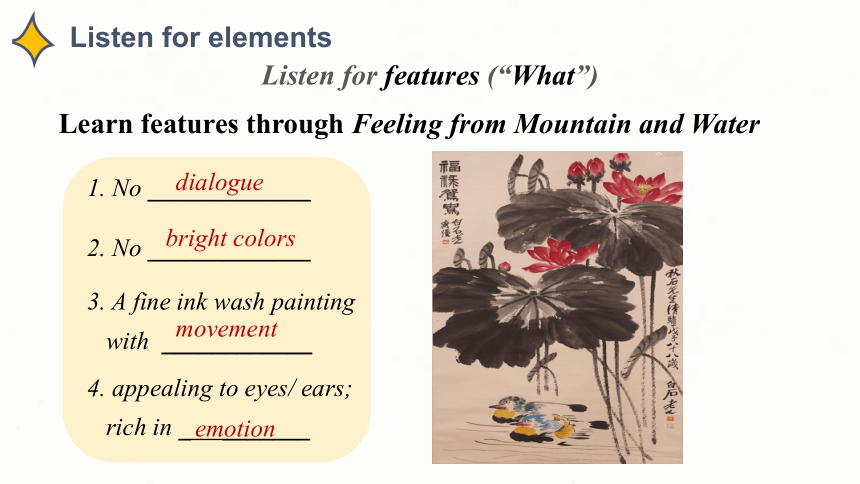
文档简介
(共17张PPT)
Unit 1 Art
Listening and Speaking
Talk about works of art
1
acquire information about Ink wash animation ;
2
reflect on the presentation about the work of art and know how to use signpost markers;
3
build culture confidence towards Chinese art and take pride in Chinese nation.
After this lesson, you’re expected to be able to:
Learning objectives
Ink wash painting
Guessing Game
Predict our topic today (an art form and a film of this form).
The painting style of the picture
Ink wash animation
Feeling from Mountain and Water
/ n me n/
Listen for Introduction(“What”)
1. Ink wash animation style is .
A. common around the world B. unique to China
2. This style combines with .
A. Chinese traditional art; modern animation techniques
B. Chinese animation art; foreign animation techniques
Listen for elements
in the late 1950s
Inspired by
Qi Baishi
in 1960
in
After the
Tadpoles Searching for Mother
received
praise.
international
1963
The Cowboy’s Flute received the golden prize.
in
1988
Masterpiece: Feeling from Mountain and Water
high cost of producing caused to stop making them.
late 1980s
in 2016
computers
have begun to make ink wash animated film using
Listen for Background (“What”)
Listen for elements
Listen for features (“What”)
Learn features through Feeling from Mountain and Water
1. No _____________
2. No _____________
3. A fine ink wash painting
with ____________
4. appealing to eyes/ ears;
rich in _ _______
dialogue
bright colors
movement
emotion
Listen for elements
Review: key elements in presenting an art form(“What”)
Introduction
Background
Features
Speak for ideas
What
How
Introduction
Background
Feature
I’d like to speak to you about...
Let me start by...
Let’s turn now to...
Review: key elements in presenting an art form(“What”)
Signpost markers
Signpost markers are phrases or expressions that are used to start a new point, to give an example, to summarize.
Speak for ideas
Listen for signposts (“How”)
Listen and tick the signposts words
Listen for signposts
Speak for presentation
Paper-cutting
Craftsmanship
Speak to present
Introduction:
______________ paper-cutting. Paper-cutting is one of the most popular Chinese traditions.________, People also give paper cutting works as gifts.
Features:
_________________features. It is usually made of red paper. __________, it is cheap and easy to make, and it can be seen on walls, windows, doors, mirrors, lamps and so on
Background:
____________its background. Paper-cutting can date back to the 6th century. ______, in 7th -13th century, it became popular during Chinese festivals.
Jigsaw presentation
My topic today is
Let’s start by
Let’s turn now to
Later
Moreover
Furthermore
I’m glad to have this opportunity to …
Today, I’d like to talk/speak (to you) about …
My topic today is …
First, let me tell you about …
Later,...
After that,...
Let’s turn now to the …
In addition,...
More important,...
Speak for presentation
Checklist to guide your presentation
Item Checklist Rank
1 Are our signposts properly chosen
2 Do we have correct pronunciations and proper intonations
3 Do we present our contents fluently
4 Do we have a natural switch among different speakers
Standards for evaluation: A-excellent(10`); B-good(8`); C-average(6`); D-need improvement(4`)
Speak for presentation
Peking Opera
China’s cultural treasure
UNESCO Intangible(/ n t nd bl/) Cultural Heritage List (2010)
1790, Four Great Anhui Troupes(“四大徽班”).
from 1840 -1860, combination of Huixi, Qinqiang, Handiao, Kunqu and Jingqiang.
standardized and fixed process and form
virtualized performances rather than rich props(道具) various acting forms.
Hanfu
traditional clothing of Han People
a significant culture
the Huangdi(黄帝) age
in 1644, banned
in modern years, revived
loose and flowing shape
virtues of fairness, integrity(/ n teɡr ti/正直), and inclusiveness(包容)
Jizhou Ware
a historical and artistic legancy
highly prized for its beauty and function
appeared during the Song Dynasty
a strong local style and the han nationality art features
known for black and white glaze[/ɡle z/](釉)
prduced for daily use
1. Polish materials from your group to make a complete presentation by yourself.
2. Choose a new art form , collect relevant information and make a new presentation.
Homework
Unit 1 Art
Listening and Speaking
Talk about works of art
1
acquire information about Ink wash animation ;
2
reflect on the presentation about the work of art and know how to use signpost markers;
3
build culture confidence towards Chinese art and take pride in Chinese nation.
After this lesson, you’re expected to be able to:
Learning objectives
Ink wash painting
Guessing Game
Predict our topic today (an art form and a film of this form).
The painting style of the picture
Ink wash animation
Feeling from Mountain and Water
/ n me n/
Listen for Introduction(“What”)
1. Ink wash animation style is .
A. common around the world B. unique to China
2. This style combines with .
A. Chinese traditional art; modern animation techniques
B. Chinese animation art; foreign animation techniques
Listen for elements
in the late 1950s
Inspired by
Qi Baishi
in 1960
in
After the
Tadpoles Searching for Mother
received
praise.
international
1963
The Cowboy’s Flute received the golden prize.
in
1988
Masterpiece: Feeling from Mountain and Water
high cost of producing caused to stop making them.
late 1980s
in 2016
computers
have begun to make ink wash animated film using
Listen for Background (“What”)
Listen for elements
Listen for features (“What”)
Learn features through Feeling from Mountain and Water
1. No _____________
2. No _____________
3. A fine ink wash painting
with ____________
4. appealing to eyes/ ears;
rich in _ _______
dialogue
bright colors
movement
emotion
Listen for elements
Review: key elements in presenting an art form(“What”)
Introduction
Background
Features
Speak for ideas
What
How
Introduction
Background
Feature
I’d like to speak to you about...
Let me start by...
Let’s turn now to...
Review: key elements in presenting an art form(“What”)
Signpost markers
Signpost markers are phrases or expressions that are used to start a new point, to give an example, to summarize.
Speak for ideas
Listen for signposts (“How”)
Listen and tick the signposts words
Listen for signposts
Speak for presentation
Paper-cutting
Craftsmanship
Speak to present
Introduction:
______________ paper-cutting. Paper-cutting is one of the most popular Chinese traditions.________, People also give paper cutting works as gifts.
Features:
_________________features. It is usually made of red paper. __________, it is cheap and easy to make, and it can be seen on walls, windows, doors, mirrors, lamps and so on
Background:
____________its background. Paper-cutting can date back to the 6th century. ______, in 7th -13th century, it became popular during Chinese festivals.
Jigsaw presentation
My topic today is
Let’s start by
Let’s turn now to
Later
Moreover
Furthermore
I’m glad to have this opportunity to …
Today, I’d like to talk/speak (to you) about …
My topic today is …
First, let me tell you about …
Later,...
After that,...
Let’s turn now to the …
In addition,...
More important,...
Speak for presentation
Checklist to guide your presentation
Item Checklist Rank
1 Are our signposts properly chosen
2 Do we have correct pronunciations and proper intonations
3 Do we present our contents fluently
4 Do we have a natural switch among different speakers
Standards for evaluation: A-excellent(10`); B-good(8`); C-average(6`); D-need improvement(4`)
Speak for presentation
Peking Opera
China’s cultural treasure
UNESCO Intangible(/ n t nd bl/) Cultural Heritage List (2010)
1790, Four Great Anhui Troupes(“四大徽班”).
from 1840 -1860, combination of Huixi, Qinqiang, Handiao, Kunqu and Jingqiang.
standardized and fixed process and form
virtualized performances rather than rich props(道具) various acting forms.
Hanfu
traditional clothing of Han People
a significant culture
the Huangdi(黄帝) age
in 1644, banned
in modern years, revived
loose and flowing shape
virtues of fairness, integrity(/ n teɡr ti/正直), and inclusiveness(包容)
Jizhou Ware
a historical and artistic legancy
highly prized for its beauty and function
appeared during the Song Dynasty
a strong local style and the han nationality art features
known for black and white glaze[/ɡle z/](釉)
prduced for daily use
1. Polish materials from your group to make a complete presentation by yourself.
2. Choose a new art form , collect relevant information and make a new presentation.
Homework
